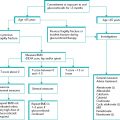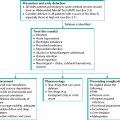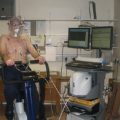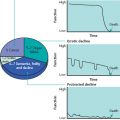The problem of falls
For research purposes, the definition of a fall is ‘unintentionally coming to rest on the ground or some lower level and other than as a consequence of sustaining a violent blow, loss of consciousness, or sudden onset of paralysis as in stroke or epileptic seizure’. Around one-third of people over the age of 65 living in their own homes fall each year. Half of all falls occur in the home, during routine activities of daily living, often with no obvious environmental hazard. The incidence of falls is higher for those living in institutions. Around half of care home residents who are mobile fall each year.
Falls in older people are more likely to lead to injuries. These occur in 50% of cases, mostly minor. In 1999 there were around 650 000 emergency department attendances for fall-related injuries in the over 60s. Even without an injury, some fallers are unable to get off the floor by themselves, which can lead to a ‘long lie’ causing dehydration, hypothermia, pressure sores and pneumonia. Falls also lead to loss of confidence and fear of falling. After a fall, half of older people report a fear of falls, and one-quarter limit their activities.
Around 5% of falls in older people lead to fractures. There are 86 000 hip fractures each year in the UK and 95% of these are the result of a fall. The total cost to the National Health Service is £ 1.7 billion per year – and this does not take into account loss of independence, reduced quality of life and costs to carers and social services.
Why do older people fall?
Falls in older people can be categorised into one of three groups:
- fall due to an acute illness
- single fall, which may be accidental
- recurrent falls.
A fall can be the presenting complaint for a range of acute illnesses in older people, and if faced with a person who has just fallen, you should screen for these (Box 4.1). The most common precipitating actor is infection, but others include haemorrhage, acute coronary syndromes and metabolic disturbances such as hyponatraemia and hyper- or hypoglycaemia.
Box 4.1 Screening for acute illness in a patient who has just fallen
History
- Of the fall itself (acute illness is more likely if new onset of frequent falls)
- Review of systems (e.g. symptoms of infection, new weakness)
- Medication review
Examination
- Of any injuries
- Vital signs, including respiratory rate
- Conjunctivae for severe anaemia
- Chest, abdomen and basic neurology (speech, visual fields, limbs)
- Lying and standing blood pressure (see Box 4.4)
- Watch the patient walk (see the ‘get-up-and-go’ test, Box 4.3)
Tests (depending on the facilities available)
- 12-lead ECG
- Urine dipstick
- Urea and electrolytes, glucose, C-reactive protein (CRP), full blood count
Remember that older patients may not have a raised white cell count or fever in sepsis (see Chapter 1), which is why the CRP is a useful test. Bacteruria in old ladies can be a normal finding and does not necessarily indicate urinary tract infection as the cause of a fall.
Figure 4.1 Stairs with a swirly patterned carpet. Ageing is associated with a decline in contrast sensitivity, or the ability to discriminate edges, accommodation and depth perception. About 10% of fall-related deaths occur on stairs and 75% of falls on stairs occur coming down, especially on the last step. Wearing bifocal or varifocal spectacles is an added risk factor for falls in this situation.
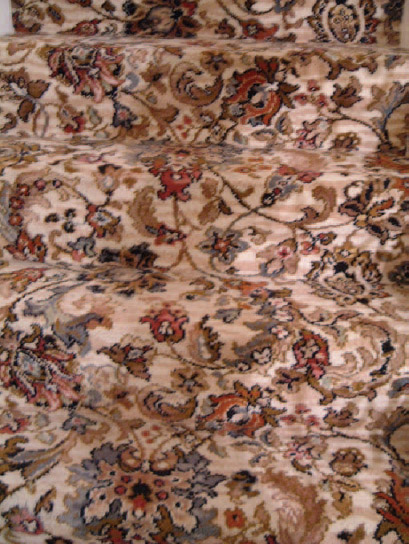
Occasionally the clinician will come across a person who has had a genuine accidental fall (e.g. slipped on ice), who has a normal gait and balance and no other risk factors for falls. However, all older people presenting with a fall should have a basic falls assessment to look for any underlying cause (see later).
This chapter is mainly concerned with recurrent falls, i.e. people who have fallen more than once. Hundreds of different risk factors for recurrent falls have been identified, and are sometimes referred to as ‘intrinsic’ (e.g. muscle weakness, balance problems, poor vision, cognitive impairment) or ‘extrinsic’ (e.g. being on four or more prescription medications, environmental hazards – see Figure 4.1). Risk factors have a synergistic effect, so that risk rises dramatically as the number of risk factors increases. Risk factors for falls can be categorised into six main groups (Box 4.2).
There are particular risk factors for falls in institutions, and there is evidence that falls could be reduced if these are addressed (see Lord et al. in further resources section).
Box 4.2 Risk factors for falls
1 Social and demographic factors
- Advanced age
- Living alone
- Previous falls
- Limited activities of daily living
2 Age-related changes
- Reduced ability to discriminate edges (e.g. stairs)
- Reduced peripheral sensation
- Slower reaction times
- Muscle weakness
3 Poor gait and balance (postural instability)
4 Medical problems
- Cognitive impairment
- Parkinson’s disease
- Cerebrovascular disease
- Eye diseases that reduce acuity (e.g. cataracts, glaucoma, age–

Stay updated, free articles. Join our Telegram channel

Full access? Get Clinical Tree


